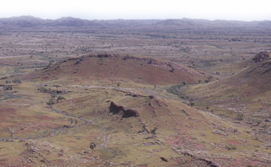Geotimes

Untitled Document

News Notes
Geochemistry
Ancient methane-makers
 Living on Earth
3.5 billion years ago was tough. The sun was faint and weak, and there were
no plants, no animals and not much oxygen. But some hardy methane-breathing
microbes did make a go of life back then, and they were living and “breathing”
700 million years earlier than previously thought, according to new geologic
evidence. The discovery helps fill in the gaps about Earth’s early climate
and the evolution of life on the planet.
Living on Earth
3.5 billion years ago was tough. The sun was faint and weak, and there were
no plants, no animals and not much oxygen. But some hardy methane-breathing
microbes did make a go of life back then, and they were living and “breathing”
700 million years earlier than previously thought, according to new geologic
evidence. The discovery helps fill in the gaps about Earth’s early climate
and the evolution of life on the planet.
Researchers extracted methane gas from
hydrothermal dikes in Western Australia and say that microbes produced the gas,
which is evidence of some of Earth’s earliest life. Photo is by Yuichiro
Ueno.
Life is thought to have emerged during the Archaean era, between 3.8 and 2.5
billion years ago, based on rocks from the time that contain carbon from a living
source. Geochemist Yuichiro Ueno of the Tokyo Institute of Technology in Japan
and colleagues have been studying ancient rocks from this period, looking for
any traces living organisms might have left. Success came in 2001, when Ueno’s
group found organic material in thin veins of rock from a region in Western
Australia called North Pole (oddly enough, one of the hottest places on Earth).
The organic material’s origin was still a mystery, but Ueno says that
he had a hunch it came from methane-producing microbes, which had existed in
the latter part of the Archaean era, according to some geochemical evidence.
So Ueno’s team sought to find what these critters would>> have left
behind: methane gas.
They examined gas in tiny bubbles trapped within growing quartz rocks dated
to 3.5 billion years ago. The bubbles contained mainly carbon dioxide and water,
with tiny amounts of methane. Before attributing this gas to microbes, however,
researchers had to rule out other potential methane sources, including the breakdown
of organic material and natural processes, such volcanic or geyser eruptions.
Methane from microbial metabolism has a distinct geochemical fingerprint —
it contains more lightweight carbon isotopes than methane from other sources.
Measuring the isotopic contents of the methane’s carbon atoms, Ueno and
co-workers found that 56 percent of the gas contained lightweight carbon atoms,
a percentage consistent with the methane having come from a living source, the
team reported March 23 in Nature.
They also checked to be sure that the gas was a byproduct of the formation
of hydrocarbons, which are created by the compression of organic material over
time. Hydrocarbon levels in the bubbles were low, however, reaffirming the researchers’
assertion that the methane came from the microbial metabolism.
The discovery, Ueno says, sheds light on the evolution of Earth’s earliest
life. The three main branches of the evolutionary tree are the domains known
as Eukarya, Bacteria and Archaea, the third group including methane-producing
microbes and other “extremophiles.” Knowing now that Archaea existed
so early in the evolution of life on Earth allows scientists to “clarify
the minimum age of the two branches,” Ueno says. That information could
help the researchers determine when the branches split off from each other and
began forming the modern tree of life.
Some researchers caution that this evidence for microbes is only preliminary,
noting that contamination and inaccurate dating of the source rocks can easily
come into play when studying such old and delicate specimens. Martin Brasier,
a paleobiologist at the University of Oxford in the United Kingdom says that
the study is “promising, but not a confirmation of life.”
If accurate, the find also helps explain an early Earth paradox: During the
Archaean, the young sun did not shine as brightly or as hot as it does today,
yet Earth was still hot. “There must have been a different, a stronger
greenhouse effect to counteract the effects of the weaker young sun,” says
Roger Buick, an astrobiologist at the University of Washington in Seattle.
Scientists had previously thought carbon dioxide was responsible for some of
the greenhouse effect at this time, but this microbial find and other evidence
point toward methane, a greenhouse gas tens of times more powerful than carbon
dioxide. Ueno’s find, Buick says, “provides evidence that methane
was around at an appropriate time” to keep Earth toasty, and perhaps pave
the way for other forms of life to evolve.
Katie Unger
Geotimes contributing writer
Back to top
Untitled Document

 Living on Earth
3.5 billion years ago was tough. The sun was faint and weak, and there were
no plants, no animals and not much oxygen. But some hardy methane-breathing
microbes did make a go of life back then, and they were living and “breathing”
700 million years earlier than previously thought, according to new geologic
evidence. The discovery helps fill in the gaps about Earth’s early climate
and the evolution of life on the planet.
Living on Earth
3.5 billion years ago was tough. The sun was faint and weak, and there were
no plants, no animals and not much oxygen. But some hardy methane-breathing
microbes did make a go of life back then, and they were living and “breathing”
700 million years earlier than previously thought, according to new geologic
evidence. The discovery helps fill in the gaps about Earth’s early climate
and the evolution of life on the planet.

